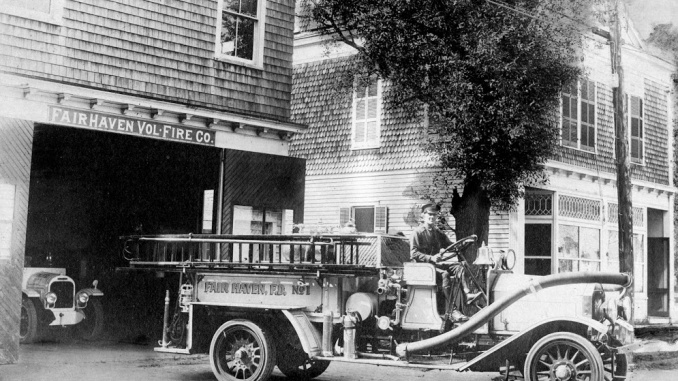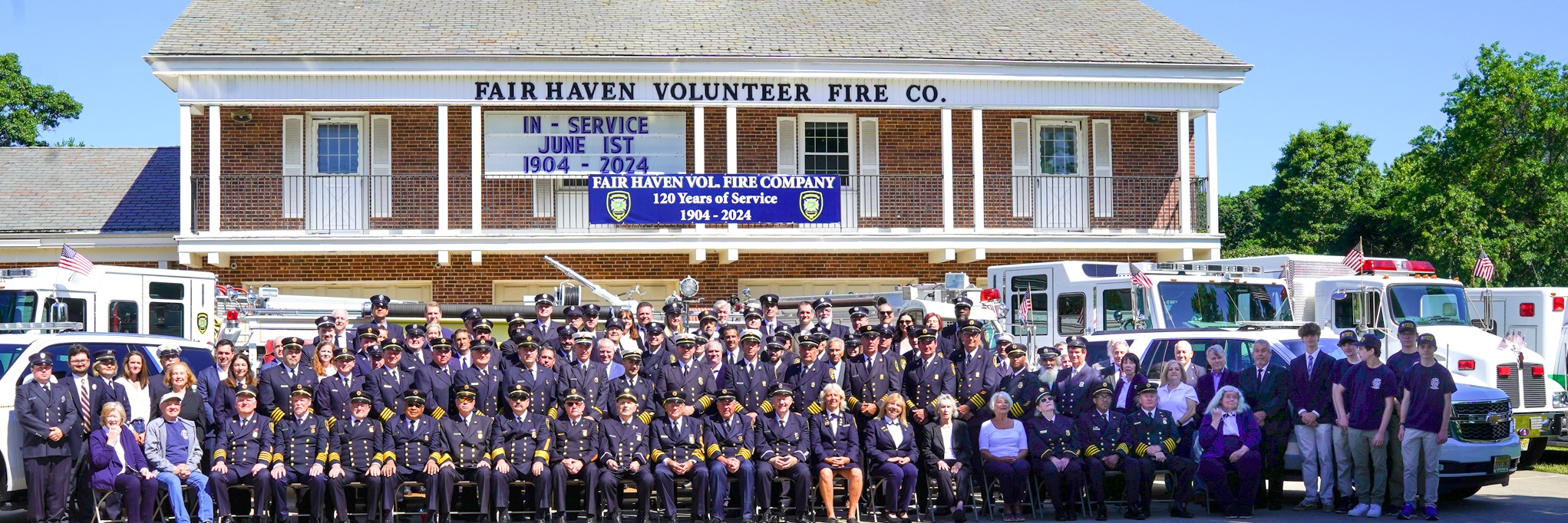History of the Fair Haven Fire Department
Around 1900, the permanent population of Fair Haven and its surrounding area was about 1,000 persons. Naturally, fire always was a concern of rural areas and Fair Haven was no exception. Fire insurance was not carried by some residents and businessmen. A disastrous fire could literally wipe out an entire life’s investment and leave the victim ruined. It could be possible that a great fire involving several structures in the village could ruin the community itself. An effective fire fighting organization was what was needed if losses were to be kept to a minimum.
About ten years prior to the formation of a fire company in Fair Haven, a local Black man, William Henry Lyons, Jr., had organized a bucket brigade which included the following members: William Brown, Edward Hicks, Joseph Hicks, Frank Johnson, Herbert Johnson, and Joseph Johnson. Also C. Frederick Lyons and Mr. Woodson were part of this group who were volunteers without pay and provided their own pails. One of the fires which this group responded to was at the cigar factory of E. H. Wilber, known to residents as the “Eel Pot”. This fire occurred about 1895, and the “Eel Pot” was saved by the bucket brigade’s work. Another fire in the village had brigaders hastening the occupants of the burning dwelling out of the house before they could attempt to extinguish the flames. Little is known about the above brigade other than what is related here.
Fire protection by means of a bucket brigade was outmoded at the turn of the twentieth century.
The people of Fair Haven talked about the formation of a fire department for some time, and finally concentrated their efforts toward fire protection. The neighboring village of Oceanic and the town of Red Bank already had fire protection, but other parts of the township including Little Silver, East Oceanic (Rumson), and Fair Haven did not. East Side Park came under the protection of Red Bank and eventually Red Bank serviced a part of that area with the Red Bank water system.
 While the talk on fire protection continued, so did numerous fires. On November 23, 1902, the stillness of an autumn Sunday night was broken by the ringing of the school bell, which was used as a fire alarm. The fire was in the kitchen of Josephine Hendrickson’s house. A large crowd was attracted to the blaze which burned the dwelling and its contents to a total loss, and no insurance was carried by the unfortunate owner.
While the talk on fire protection continued, so did numerous fires. On November 23, 1902, the stillness of an autumn Sunday night was broken by the ringing of the school bell, which was used as a fire alarm. The fire was in the kitchen of Josephine Hendrickson’s house. A large crowd was attracted to the blaze which burned the dwelling and its contents to a total loss, and no insurance was carried by the unfortunate owner.
The following afternoon, sparks from a chimney set the roof of James Van Brunt’s home ablaze. A few men were nearby, the women summoned help, and the fire was subsequently extinguished before much damage was done. Later that evening, Daniel Lee’s roof also caught fire, supposedly from sparks emitting from a steam roller in use on River Rd. Again this blaze was put out before much harm was done, but three fires in a twenty-four hour period was too much.
The fire situation had not improved during the following months and on Saturday night, May 2, 1903, another potential disaster struck the home of L. B. Battin. With the family assisting, William Bennett and Raymond Doughty saved the dwelling. During the blaze, it seemed for a time that the house would be lost but fortunately only the roof was severely damaged.
The above patterns of fires in Fair Haven continued for awhile longer before decisive action was taken. In January, 1904, at East Side Park, the potential loss from an overturned oil lamp was averted by the quick response and work by four men who were neighbors of the homeowner. A house on Haggers Lane was a total loss despite use of a bucket brigade and hand-pumping which caused three wells to go dry.
The people of Fair Haven now finally realized that a fire company must be formed. In February, 1904 some of the leading townsmen of Fair Haven set the date of Wednesday evening, March 9, 1904 for a public meeting on the subject of fire protection and formation of a fire company. This meeting in the hall of the Junior Order of United American Mechanics on Pearl Street (now Fair Haven Rd.) was set for 8 P.M. Notice of the meeting was signed by the following: George W. Smith, J. R. Scott, A. E. Smith, R. D. Chandler, Elwood Smith, Harry Dennis, J. J. Hendrickson, H. J. Schneider, Stanley Fielder, C. D. Chandler, John W. Fielder, John L. Bennett, R. S. Merritt, E. H. Wilber, W. H. Bennett, F. R. Smith, G. H. Minton and Frank Mulvihill.
Eight of the above signers and eight other members were later listed as incorporators when the company was incorporated on June 1. The result of that March 9 meeting produced a volunteer unit that was called the Fair Haven Volunteer Fire Company. By March 30 the initial phase of organizing was completed, with about fifty names on the roll. The charter membership list was closed that night, and as the initiation fee was one dollar to charter members, it can be assumed that the company started its long career with about $50.00 in its coffers.
On Wednesday evening, June 1, 1904, almost three months after it was formed, the Fair Haven Volunteer Fire Company was issued the Certificate of Incorporation drafted by Edward W. Wise, a Commissioner of Deeds for New Jersey.
The new organization was quick to proceed with plans for the first priorities, such as fire house, equipment, funds to defray the expenditures, and membership. Frank Mulvihill, a plumber by trade, was selected as the first Fire Chief. He had been a signer of the original petition that called for the March 9 meeting, as well as later becoming one of the sixteen incorporators. Frank Mulvihill, whose term as chief lasted until July, 1907, started a family tradition as subsequently his brother, John, and nephew John Mulvihill, Jr., and his great nephew Jack Mulvihill, became chiefs in 1920, 1955, and 1989, respectively.
Little details about the actual offices and committees that were formed in the early years have been passed down to us. Quite certain the meetings were conducted by a presiding officer. Officers were to be elected at the March 30, 1904 meeting at which time it was also decided that an annual meeting should be held in July. At the first annual meeting in July, 1904, all of the officers were continued in office. Committees mentioned in those formative months of 1904 included subscriptions (seeking fund for equipment), whose report at the Monday, May 2, meeting stated that nearly $400 had been pledged towards the needed apparatus. Other committees were designated to plan the company’s first ball that May, select the fire equipment, and make plans for building the new fire house.
Records indicate during the year of 1920 the fire company opened their roster to include “social membership”. These men were over the acceptable age limit of active firemen. However, they perform such duties as serving on committees, hold office other than line office and serve as first aid or fire policemen. They have proven to be a valuable asset to the fire company.
